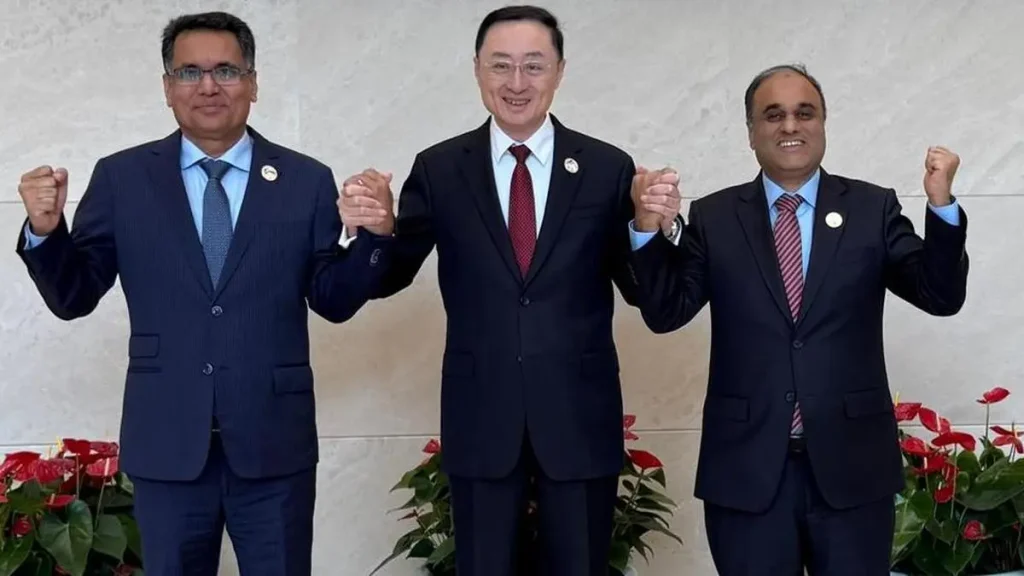Pakistan-China-Bangladesh Trilateral in Kunming: A Strategic Shift in South Asia?
China’s Vice Foreign Minister Sun Weidong, Bangladesh’s Acting Foreign Secretary Ruhul Amin Siddiqui, and Pakistan’s Additional Foreign Secretary Imran Ahmed Siddiqui attended in person. Pakistan’s Foreign Secretary Amna Baloch participated virtually.
While China and Pakistan described the meeting as the launch of a “trilateral cooperation mechanism,” Bangladesh opted for a more cautious label, referring to it as an “informal dialogue”—a reflection of its interim government’s limited diplomatic bandwidth.
The trilateral framework is being positioned as a platform for cooperation in trade, maritime connectivity, climate adaptation, agriculture, education, and cultural exchange. Although still early, this format could evolve into a critical forum in the South Asian diplomatic landscape, one that India will likely view with unease.
Tensions have grown between India and Bangladesh following the exit of Sheikh Hasina’s pro-Delhi government. Since March 2025, under interim Prime Minister Dr. Muhammad Yunus, Dhaka has shifted its foreign policy posture. Dr. Yunus’s visit to Beijing earlier this year signaled a shift where Bangladesh is now deepening ties with both China and Pakistan. In doing so, it has pivoted away from the close strategic alignment with India that defined the Hasina era across sectors like economic cooperation, regional integration, and intelligence sharing.
The emergence of a Pakistan-China-Bangladesh axis introduces a fresh strategic headache for New Delhi. India has long viewed Chinese encirclement through the “String of Pearls” strategy with apprehension. With the China-Pakistan Economic Corridor (CPEC), Gwadar Port, and Colombo’s Hambantota already in place, the Kunming dialogue adds a new layer to Beijing’s South Asia engagement.
Bangladesh’s current economic stress further complicates matters for India. Facing mounting fiscal pressure, Dhaka has turned toward Chinese-backed institutions. In 2025, it secured $400 million from the Asian Infrastructure Investment Bank (AIIB) for climate-related projects. The AIIB, headquartered in Beijing, stepped in as U.S. development aid declined. During Dr. Yunus’s visit to China, Dhaka was promised a combined $2.1 billion in investments, loans, and grants. Chinese commitments span infrastructure, healthcare, robotics, and defense technology.
A particularly sensitive area is the proposed Chinese involvement in Bangladesh’s Teesta River project and a planned airport near the Indian Siliguri Corridor,an area of strategic vulnerability for India that connects its mainland to the northeastern states. For Indian policymakers, these developments raise serious security concerns.
China’s role in drawing Bangladesh closer to Pakistan is matched by its influence in improving Pakistan-Afghanistan relations. In recent military tensions between Pakistan and India, Chinese-origin fighter jets and surveillance systems were widely reported to have strengthened Pakistan’s posture. If Myanmar, like Bangladesh, joins China-led development corridors, it could also threaten India’s long-planned highway linking it with Thailand and Southeast Asia.
Public sentiment in Bangladesh is shifting as well. A 2025 opinion poll showed that 75% of Bangladeshis view China positively and 59% express favorable views toward Pakistan. By contrast, only 11% held positive views of India—a stark reversal from earlier trends. Irritants such as river water disputes, visa restrictions, and New Delhi’s sheltering of Hasina loyalists have deepened public dissatisfaction.
For Pakistan, this diplomatic strategy offers considerable opportunity. Bilateral tensions with Bangladesh have eased, and Dhaka now appears poised to play the role of a constructive regional partner, one grounded in trade, diplomacy, and balanced foreign policy. While India weighs its options, Islamabad is already reaping the early dividends of strategic patience and regional outreach.

